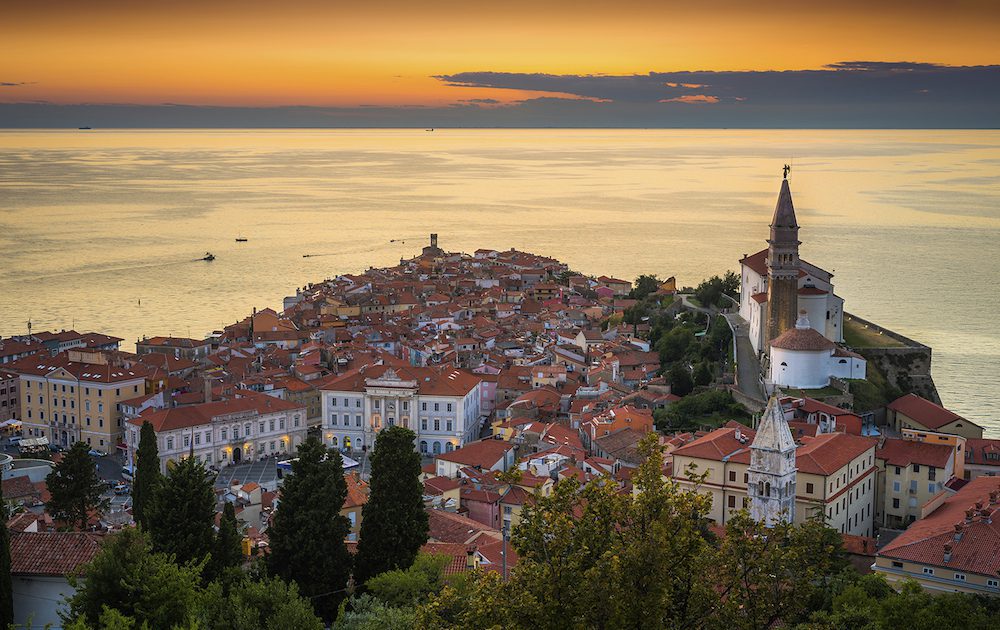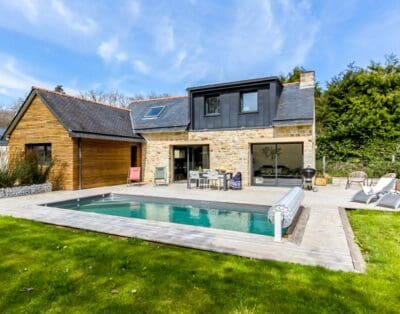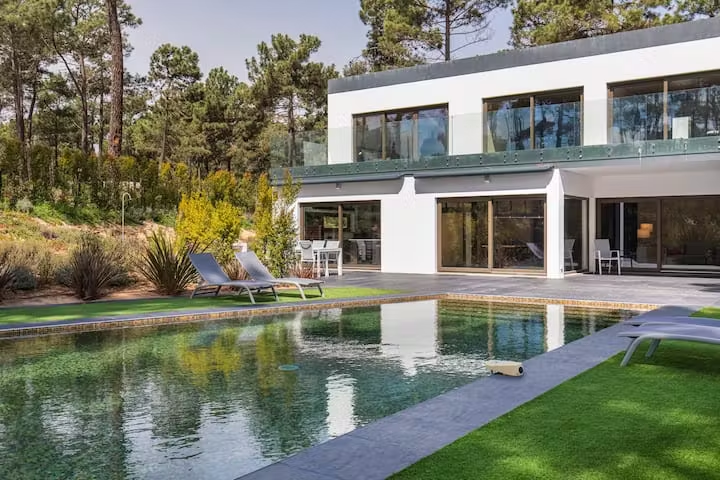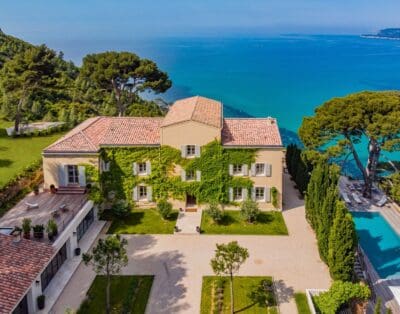Medievel Picturesque Piran In Slovenia
If when taken blindfold to the middle of the village square in medieval Piran; when you open your eyes you would fully expect to be in the centre of a film set. Not a jarring building to behold, looking one way you will see a Venetian church tower on the hill overlooking everything, on the square itself is another church. Turn one way and there is an arc of grand neo-classic buildings, turn the other way and an arc of vernacular smaller buildings are all in harmony. Complete the circle with the quayside of the harbour with its eclectic collection of small boats gently bobbing at their moorings.
Behind the film set of the main square is a labyrinth of closely knit streets with a few much smaller squares to add to this Mediterranean idyll. Despite the number of tourists in summer, little has changed in recent decades. Those looking for second homes and restoration projects will be rewarded as opportunities abound.
Piran is a little Venetian port on Slovenia’s very short Mediterranean coastline wedged on the Istrian peninsula between Italy and Croatia; Venice is not far across the water. However, less than an hour’s drive away are the Julian Alps with stunning scenery, in between there are vineyards and gloriously untouched countryside through the Soča Valley passing a few villages and towns on uncrowded but tortuous local byways.
Slovenia only has a population of two million inhabitants, it is remarkable that they have such a good infrastructure complete with a high standard of education; English is widely spoken. They are very much a country that compares well with its neighbours and beyond, their ethos is more like a northern European country but much more relaxed; I would describe its location as on the southern boundary of Austria rather than associating it with, say, Croatia. The Istrian peninsula has had a turbulent past as it has passed between several jurisdictions through the centuries; there are certainly Italian and Austrian characteristics and influences all around on the western half of the country which adds further interest.
A couple of miles along the coast from Piran is Portorož, a 19th century purpose-built resort with some great neo-classic villas, a majestic palace hotel, plus the inevitable less considered modern additions but they are far less harmful than in Cannes which bears more than a passing resemblance. It is a pleasant walk between the two villages; a vast but still not unattractive warehouse was built in Napoleonic times. The purpose of this amazing building was to store the highly profitable salt from the local salt pans. Nowadays, the salt is used for numerous purposes including a gallery.
We stayed in the Tartini Hotel which has the very best position of any hotel in Piran village; right on the square. It’s interior as an ‘Art Hotel’ of the mid-nineteen nineties. Nothing really has been changed since, whilst the furniture is definitively 1990’s wacky style, the bathrooms could do with an up-date. Nevertheless, it has character and lots of pictures on the public spaces’ walls.
Our visit was in the off-season when we knew most restaurants would be closed and that included both the Tartini Hotel’s more formal restaurant and bistro, both of which have a great reputation. However, the off-season has its attractions in being able to have quiet experiences in mild but generally sunny conditions with effectively only the local population around. We ate in two local restaurants, at Ivo’s we had excellent small stuffed squid and the catch of the day’s fish at Pri Marie which was so fresh. Good restaurants are expected to match their house wines to the quality of the food; both failed miserably. We have really enjoyed the wine from a local white grape; malvasia but in both restaurants it was undrinkable, so we drank a local spirit Traveritca.
Restoring our confidence in the grape variety we were taken along a short pier with no bar or commercial signs in sight; puzzling. An un-advertised local fishing boat had an awning covering the aft deck, we ducked inside into a very warm atmosphere as they served wine to their local guests and the malvasia wine was really good. That was a real find and we cherish the memory.
Apart from that bad experience, Slovene wine is very palatable with anything from a sparkling (quite heavy) red to a rosé, which was summer in a glass with all the summer fruits tickling your palate. We visited the winery developed by the Rodica family, they started out with one hectare of vines in 1998 and soon found that they had the skills to produce significantly palatable wines. 2005 saw the transition from the near hobby approach to a serious but ‘boutique style’ endeavour.
In 2013 the Rodica family built the dream winery near the top of a hill miles from anywhere; no ugly sheds here. After wending our way on mainly effectively single track roads from the port of Koper, we arrived at the winery. Initially there was little to see except a short wall and a large door projecting from the side of the hill; it turned out that the winery was far bigger than our first glimpses had indicated. The winery combines the processing areas with their gleaming stainless steel alongside oak and oak and acacia barrels (the latter for white wines) and the extensive tasting and dining areas. It would be hard to better the superb location with its large windows in the tasting areas overlook the valley below and beyond to distant hills. You would never expect to discover such a large and well-designed structure in this location. Virtually all the building you can see on the approach is underground being covered in soil and grassed on their hill top location but views across the valley from inside the winery are to die for.
Tasting the wines was also to die for, the grapes are organic; importantly they are hand-picked. No chemicals are needed to get rid of all the nasty things that mechanical pickers cannot discard, such as vermin and other undesirables. The resultant wine is superb and its purity effectively eliminates any thoughts of a hangover. I have to mention the thinnest of homemade hand cut air-dried ham we ate between tastings as it was certainly absolutely the best we have ever eaten in over thirty years!.
The conditions for cycling are excellent as long as you do not mind the occasional alp or whole range of alps. It is not a big country and certainly in a car, you can see a great variety of landscape interests. There are lots of suggested cycling itineraries on the web – you can cover lots of differing terrains without getting caught up in traffic. Just about wherever you go, there is fairly light traffic. We avoid motorways whenever we can as passing through on the byroads, the countryside and villages bring the whole experience to life.
Piran is well placed as it is in a prime location to add the Mediterranean to any cycling tour. In addition, Croatia is just a few miles away where we found some interesting villages. There are designated wine and olive roads to explore. The village of Buje dates back to Roman times but there are bronze age traces around, the approach is not flattering. However, once on the hilltop you are engulfed by ancient buildings, the most prominent of which is the church with its high tower. We were greeted by a local resident who had the church key and he showed us around with an accompanying description of the various aspects, including some rather scandalous tales from the 1960s. I am fairly sure these are not on the official guiding notes, if any exist. Many of the buildings need extensive renovations and no one seems to have any energy or money to start the ball rolling despite the potential.
Nearby is the ‘artists’ village of Groznjan which is a very different story whereby the whole village looks to be in good shape, lots of apartments and rooms in which to stay over. Not one of the reported 35 artists’ studios was open on our autumn Sunday visit but a couple of shops and bars were open. Who has heard of local artists not wanting to sell pictures to people arriving to do exactly that? I would suggest as was later confirmed, the prices were hiked far above other artists’ studios in the area.
My preferred route from Piran would be to e-cycle through the Goriska Brda vineyards, up through the magical Soča valley to the lakes Bohinj and Bled. The route is longer than I would consider but I am still tempted as it is a special experience to be enjoyed. However, you can take much shorter routes and still cover superb scenic roads
Piran and Portorož Tourist Office: www.portoroz.si/en/
Piran Hotel: www.hoteltartini.si/en
Winery: www.rodica.si/en/







